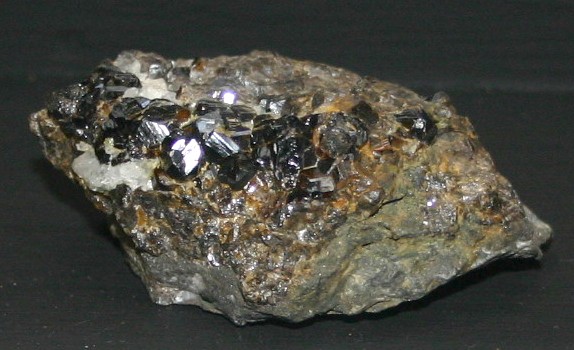Table of Contents
When a tin-bearing mineral is heated before the blowpipe with carbonate of soda or charcoal, white metallic tin is yielded. By dissolving this in hydrochloric acid and adding metallic zinc, the tin will be deposited in a spongy form. In the blowpipe assay, tin leaves a white deposit behind it, which cannot be driven off in either flame. If it be moistened with nitrate of cobalt solution, the deposit becomes bluish green, and this test distinguishes it from other metals. The most important ore is:
Cassiterite (tin ore, oxide of tin, tinstone)
- Massive and in grains.
- Crystallization—in square prisma, octahedral.
- Colour—when pure, which is rarely the case, colourless and transparent, but usually brown, sometimes greyish or whitish, and occasionally reddish (as in Australia) ; transparent red crystals are rare.

- Nearly opaque, and a resinous, submetallic lustre.
- Streak—brownish.
- H. 6 to 7; S.G. 6·5 to 7·1.
(N.B. Is much harder than zinc blende, for which it may, perchance, be mistaken. Is usually almost as hard as quartz, scratching glass.) Contains, when pure, 78% tin.
Is infusible alone before the B.F., but with carbonate of soda metallic tin is yielded. Insoluble in acids, whereas zinc blende is easily soluble in hydrochloric acid.
Cassiterite or tinstone, SnO2. Most of the world’s tin production comes from placers. While Canada, on account of extensive glaciation, is not in a favorable position in this respect, placer tin may be discovered in prospecting for gold placers. Tinstone being very hard and very heavy, accumulates with gold in gravel and sand, and in panning will show as a heavy tail of black or dark brown grains, which will turn light brown or nearly white when finely powdered.
Tinstone is found in pegmatite dikes (often called veins) and in quartz veins in intrusive granite, and in quartz-porphyry. These veins are also found in the slate and other stratified rocks intruded by the granite. The granite in the neighborhood of the veins is altered to greisen, a white or gray rock composed mostly of white mica and quartz. Other ore minerals found in tinstone veins are molybdenite, wolframite, scheelite, mispickel, bismuth, and bismuthinite; pyrite, copper pyrites, galena, and zinc blende may be present. The greater part of the gangue is quartz, but lithium mica, fluorspar, topaz, tourmaline, axinite, and apatite are commonly present. In Cornwall tourmaline is very plentiful in large masses, called schorl. Silver and gold may occur in important amounts, as in Bolivia. The minimum amount of tin that will pay to extract from the rock is 1½% to 3%, varying according to circumstances.
Stream Tin
Is the ore found as rolled fragments of tinstone in the beds of streams or low-lying gravels.
Wood Tin
Is an uncrystallized fibrous form of the mineral rather like dry wood, generally of a light brown colour, variegated with yellowish and dark concentric bands. Tin ore sometimes resembles dark garnets, black zinc blende, &c.
Bellmetal Ore (sulphide of tin)
A rare ore, found massive and crystallized in cubes.
- Colour—steel grey.
- Streak:—black.
- Structure—brittle.
- H.—4; S.G.—4·3 to 4·6.
- Composition—27 per cent, tin; copper, iron, and sulphur.
- Soluble in aqua regia.
- Veins of tin ore traverse granite, gneiss, mica, slate, rhyolite.
Tinstone is frequently scattered about country rock near the walls of a lode.
In Cornwall the lodes generally run east and west, and the average dip is 70°; some also run across these. The ore is also found as a series of small veins in friable granite; also in masses, and as stream tin, as well as in veins between certain rocks and parallel to their beds. The true veins traverse granite and killas. In Queensland tin is obtained from a deposit, and also from lodes through granite rocks. In Tasmania from deposits and from lodes in a porphyritic rock. In New South Wales quartz veins carrying tin run through granite. The alluvial deposits of the Malay Archipelago are doubtless derived from veins in granite, and so are those in Burmah.
